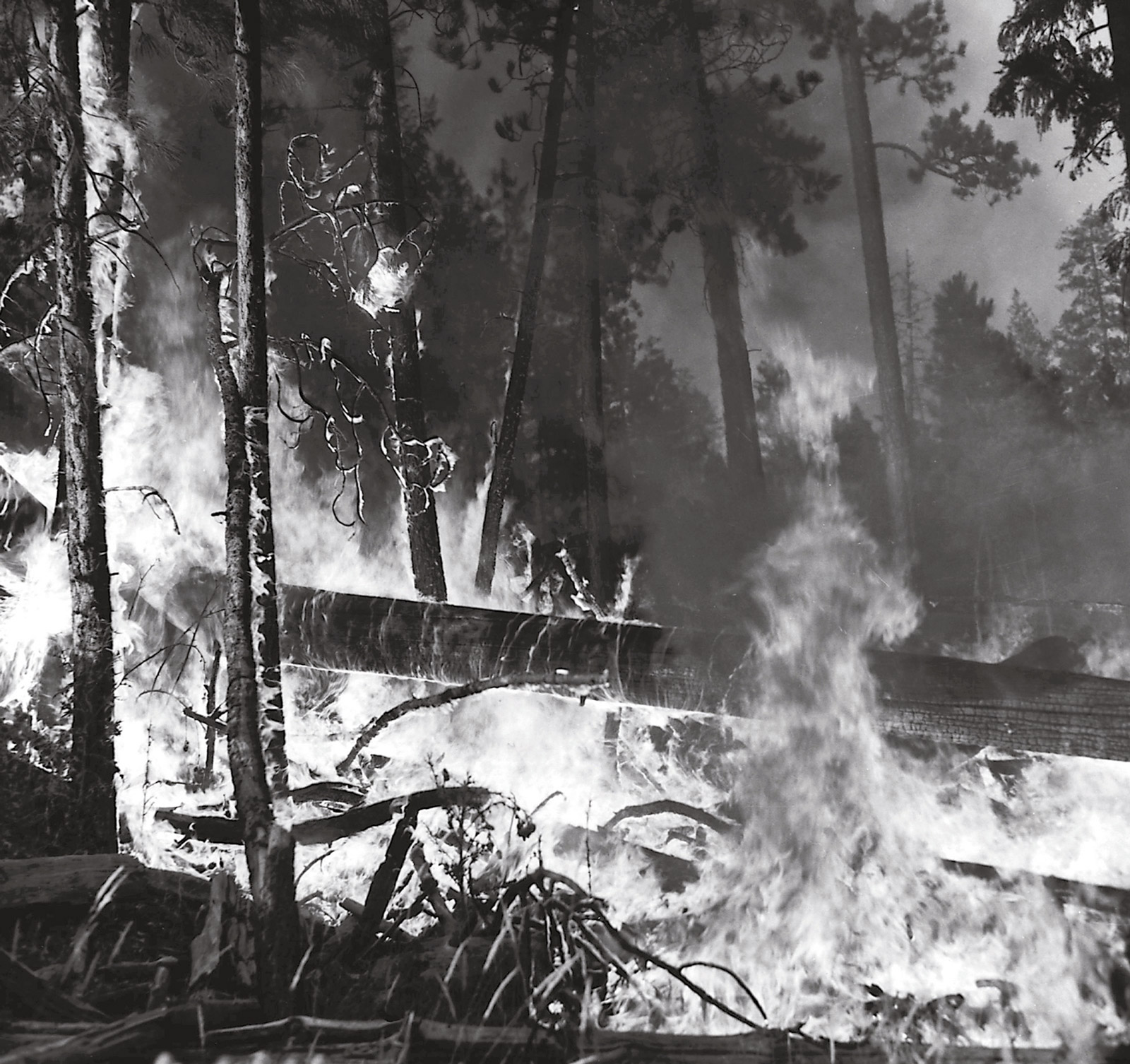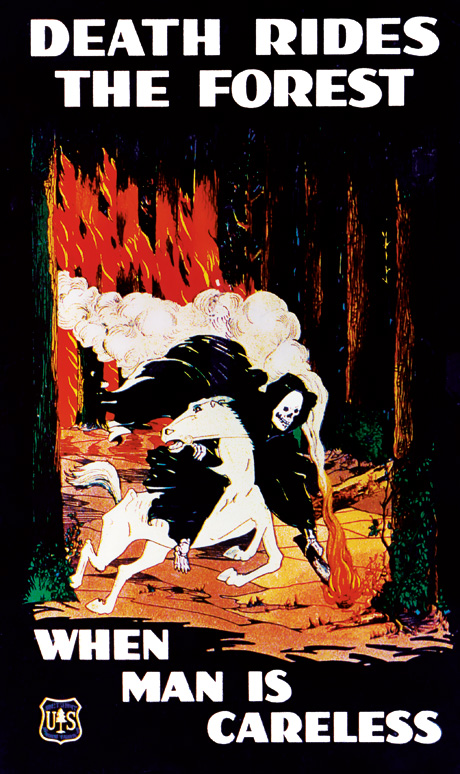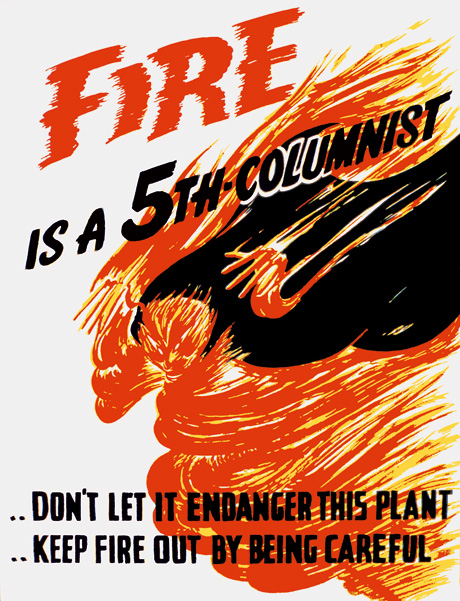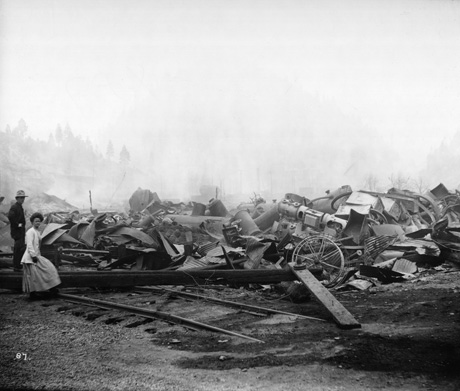The Great Integrator: An Interview with Stephen J. Pyne
Fire in North America
Jeffrey Kastner and Stephen J. Pyne
Harnessing fire’s ferocious physical force in the service of hunting, agriculture, and industry gave humanity the power to alter an often inhospitable landscape for its own purposes. Yet our control over fire remains imperfect at best. Unchecked in nature, it remains a constant, unpredictable threat to the very civilization to which it gave rise. The rich socio-cultural effects of this biological phenomenon have been the focus of environmental historian Stephen J. Pyne’s work for nearly three decades. Author of over a dozen books on the history, ecology, and management of fire, Pyne—Regents’ Professor in the School of Life Sciences at Arizona State University—recently spoke with Jeffrey Kastner about the arrival of fire in North America, its uses by successive groups of settlers, and its role in the development of modern approaches to forestry management.
Cabinet: You start your book, Fire in America, with an explanation of the principles of fire behavior. Can you walk us through the physics of fire in the natural environment?
Stephen J. Pyne: Fire is a chemical reaction, a very rapid oxidation of hydrocarbons. The zone of that reaction is shaped by physical surroundings. This includes things like terrain: Are you going uphill or downhill, through mountain passes or valleys? It would also include weather and climate: Is it dry, wet, windy? And then there’s the stuff that actually burns. Most of us think of it as part of the natural world—trees and pine needles and grasses and shrubs. But for understanding how fire behaves, it’s all just so much fuel, just so much combustible matter. The setting shapes the kinds of fire that result: creeping ground fire in dried peat or swamp; brisk grass fires in the prairies; blazing shrub fires and chaparral fires in Southern California; different kinds of forest fires, such as the very high-intensity fires that get into the crown, the ones that make it onto television.
Fire is not a substance like water, air, or earth. It’s a reaction: it’s purely what its surroundings make of it. This fact makes fire a great integrator, which is marvelous for someone interested in synthetic history, because fire integrates all the factors that shape how the combustibles sit on the landscape.

Is there a particular point at which fire started to be part of the ecosystem?
Fire goes back four hundred million years—we can find charcoal evidence in the geological record. The reason fire appeared when and as it did was because life was colonizing land and had created enough oxygen in the atmosphere to support combustion. At that point, lightning could supply the spark so that oxygen in the atmosphere and hydrocarbons on the land could react. So fire is literally a creation of the living world. One of our current failings is our inability to appreciate the extent to which fire is biologically constructed. It’s not just a physical event that slams into ecosystems like a hurricane or or a flood. It’s something that feeds off of, that is literally sustained by, a biological matrix. You can have a hurricane without anything living around it, but not fire.
You write about three ways in which fire came to North America—from nature, from Asia with the first humans to arrive on the continent, and later from Europe.
Let’s begin with the natural circumstance. Why does fire exist where it does? What you need is a pattern of wetting and drying. That supplies the fundamental rhythm—it has to be wet enough to grow things and then there has to be a dry period where things can dry out and burn. The majority of fires, however, are caused by humans, and, in a perhaps perverse way, I see this as furthering life’s control over fire. We ourselves are biological agents, and we can overwhelm natural ignition patterns. In the book, I emphasized the multiple sources of fire because I wanted to get away from the usual narrative of the Europeans coming in and burning everything, chopping it down, making a mess—the usual frontier story. Fire is a property of humanity: all people have fire, and only people. That story began earlier than the Europeans. The human impact of fire on the land really started when the earliest people came to North America. But it was very hard to find evidence—nobody had really looked at it that way. Since then, there have been a number of studies, including some out of Australia, that demonstrate the astonishing power of Aboriginal fire, that is, what control over ignition alone can do.
One can extrapolate from Aboriginal practice back to the North American experience?
Yes, I think so. The Aborigines have a similar economy to many early peoples here, a similar level of technology. Southern California, for example, is very similar to much of southern Australia—a Mediterranean climate prone to burn and subject to explosive winds. Accounts we have of burning by indigenous people in California from early Spanish contacts are very similar to what in Australia has been termed “firestick farming.” When you approach the subject in this way, however, you can trigger very passionate counterarguments because it gets tied up with the founding myths of the US: that it was an empty wilderness, that it was settled primarily from Europe. If it turns out that for thousands of years there were people working this way on the landscape, such an argument is difficult.
You discuss the many ways fire was used by the Native Americans—as both a hunting tool and an agricultural method.
They certainly burned for hunting—not just to drive animals, but also to create attractive feeding sites. How many hunted animals thrive in old-growth forests? None. One of the ways you can keep the landscape stirred up is by burning it. You burn to encourage other species of flora—things animals like to eat, such as berries, browse, and tubers, do well in a systematically burned landscape. You burn shrubs to produce new growth of twigs that then get used in basketry. You also burn just to keep open landscape. Australia again is an example of this—fire used in this way is about managing the land.
The second phase is agricultural fire. In this case, you prepare the fields by burning them; that way you don’t have to rely on nature to supply fuels. You can define the climate and create fire environments where there aren’t any. If you look at what happens after a burn in a mixed environment, the cycle of recovery takes about three years. In the first year, you’ve changed the structure of the place—you’ve opened it up, allowed in more sun and more wind, you’ve left lots of ash on the ground, which is a fertilizer. But even more effective is the fumigating effect of the fire. It purges the land of the resident plants and microorganisms. This cleansing doesn’t last very long; by the second year, most of the original flora has recovered, and by the third year it has pretty much re-established itself. Now that’s what happens in nature. What you do with agriculture is to apply this effect to your own purposes—you create an artificial environment in which you can introduce exotic plants, species that aren’t native there and cannot compete in a natural setting. The indigenous plants, now called weeds, will try to reclaim the land, and so the procedure has to be repeated. The Native Americans were using these techniques to introduce corn, beans, and squash—the classic Mesoamerican trilogy—and then they could supplement it with things like berries in the surrounding, similarly burned, landscapes. The system only works if you burn.


Because there’s no other way to have such large-scale effects on the ecosystem?
That’s right. You can’t do this everywhere, but where you can, you do it. This has been going on for a very long time. And in many ways, this old pattern of agriculture, which was also present in Europe, was very good from a biodiversity standpoint because it creates all kinds of habitats from the various stages of recovery and they could be used and tweaked in assorted ways.
When Europeans came to North America, they brought different approaches to fire, but they also learned from the native population, so what you get is a hybrid. The Europeans had more effective axes made of steel and they also had markets overseas; so they were willing to do land clearing on a larger scale by logging, and then export that material or use it for construction, and further convert the land. They also introduced animals—sheep, pigs, cows, horses, goats—that began replacing the wild animals and this changed both what was available to burn and, more importantly, what your interest in burning was. You now wanted to promote browse, which supports these animals, so you had to enlarge your pastures. Europeans were also accustomed to draining land, and they began burning lots of areas that were swampy or marshy or otherwise outside the normal burning system because they were never dry enough. They also introduced a whole slate of cereal crops.
In fact, much of the landscape the Europeans moved into had already been cleared, in a sense broken to the agricultural harness and adapted to fire, and they took those sites and adjusted them for their own plants and animals. They also established very different patterns of land ownership. This was important because the old patterns of fire always required that you move around the landscape, so that you were not in the same place that you were burning. But when you have fixed plots, you have to stay on them because you own them or are otherwise attached to them, and so the pattern of burning changes. It’s no longer possible to do large-scale burning—it’s now at the level of individual plots, so instead of slashing and burning and moving around the countryside, you slash and burn on a given plot and establish what is essentially a pattern of field rotation using fire.
Was this the pattern of land management that was being used in Europe?
Absolutely. The part of Europe between the Mediterranean and the boreal forests is not a fire climate, and it’s odd that the most aggressive of the settlement cultures came from a place without fire. They were always conquering fire-prone places and were confounded by flames. There was in fact plenty of fire in their own background, because they couldn’t make agriculture work without burning. But basically that whole zone in the middle of Europe is a very fire-immune place; fire exists there because people put it in. This got translated into the idea that the way to control fire was to control society, so they sought ways to eliminate fire and find an alternative. To their minds, if you used fire, you were primitive. Some of the most pyrophobic societies ended up in some of the most fire-flush landscapes and they were really stunned. And they had to find some way to come to grips with fire, because they felt they couldn’t dominate these landscapes if they couldn’t control it.
Do they bring this pyrophobic attitude to the US?
There was very much a divide between officials and people on the ground. The people on the ground all resorted to fire, because it was the only thing that worked. But the officials—academics, ministers of agriculture, foresters—all hated fire and wanted to remove it.
You talk about the figure of the English forester as the representative of the state coming in and preventing local people from using the land in the way they always had. I can imagine that being very resonant for settlers in the US as well.
The story is a very interesting one and it’s tied up with European imperialism. The great testing ground for this policy was India. In the nineteenth century, the British began to establish forest reserves there as part of a rationalizing presence, to bring order to an “unruly” place. They didn’t know what forestry meant; they had to bring in Germans to do it. A fellow named Dietrich Brandis was really the genius on this. Brandis was a tropical botanist, and found himself in the teak forests of Burma. It was here that he began moving from botany to forestry, eventually becoming Inspector General of Forests in India. The British set up reserves for teak in India, and starting in the late 1850s instituted a series of laws for resource management and fire control that they continued to develop into the 1870s. The goal was to protect wood for commerce, but arguments were also made on the basis of climate stabilization and public health. These were places that were being burned everywhere, all the time, and it was just a shock to the British. So they organized a conference in 1875 and the first question asked was whether fire control was possible and, if possible, whether it was desirable. Everything else would follow from this. And there was a split—everybody on the ground said, “This is a bad idea. You’re not going to be able do it. You’re going to make things worse.” All those predictions turned out to be true. But officialdom prevailed, and the British approach became a model for all the other imperial experiments (the French had their own style, with similar consequences). It also influenced policy here in the US. In 1891, President Harrison established forest reserves out of public land, and this was followed in 1897 by the Forest Management Act, or the so-called Organic Act, which was concerned with the question of what we do with this land now that we’ve set it aside.


Was this an ecological impulse or a commercial one?
This is simply what a civilized society did. You protected these reserves because otherwise people would cut them down and burn them up. This was a global phenomenon. If you’re a fan of the “Jungle Books,” you might have wondered what happens to Mowgli after he grows up. Well, Kipling wrote a sequel: Mowgli joins the Indian forest service and fights forest fires. So this approach had very wide currency; it was seen as progressive. The idea was that you couldn’t trust local people—you needed the intervention of high-level institutions to prevent the land from being destroyed. So in the US, the National Academy of Sciences set up a committee in 1896 to figure out what to do, and they recommended that we teach forestry at West Point—that we, in effect, militarize it. And the model for that was the US Cavalry, which had taken over Yellowstone National Park in 1886, and then all of the other national parks, and had provided the first federal fire-fighting force. It was a paramilitary model from the very start, and this was similar to what was going on with the other imperial countries as well.
A man named Gifford Pinchot, self-styled as America’s first native-born forester, was a member of the Academy’s committee. At the time, he was heading the Bureau of Forestry, which was just an obscure advisory bureau in the Agriculture Department because it didn’t control any land—that didn’t happen until 1905. But in the meantime, as part of Pinchot’s self-education in forestry, he started corresponding with Brandis, who was now back in Germany and had set up a forestry school. Pinchot went there and he later wrote that he wanted to do in this country something of what Brandis had done in India. Pinchot got impatient and dropped out, but his successor, Henry Graves, went through the whole program, actually went to India on a study tour, and even went to America’s new colony in the Philippines.
These men, who established US policy toward forestry, came to see fire control as a necessary thing, but also as a great public relations ploy. Remember we’re in the middle of the Gilded Age, a time of unrestrained capitalism, so why aren’t we turning these lands over to private use? One way to justify it is on the basis of fire control—everyone can see that the damn thing is burning up and we have to stop it! They thought the danger of fire would lessen as time went on, but they were wrong. Fire control turns out to be the defining aspect of forest management and we’re still struggling with it.
How have these original attitudes evolved over the last century?
All the questions we’re asking now were asked a hundred years ago or more. Fire fighting is now consuming fifty to sixty percent of the Forest Service budget. We thought it had been beaten down, but all we did is set up an ecological insurgency. The original intention behind the forest reserves was to rationalize usage, not to set the land aside as pristine preserves. It was very much on a par with attempts to straighten out rivers and kill predators—the idea that we can apply scientific knowledge and make it work.
A major event in the development of policy attitudes happened in 1910. Pinchot had been fired in January, and that summer his successor faced a huge outbreak of fires throughout the West, culminating in what became known as the Big Blowup when on 20 and 21 August something like 3.25 million acres in the northern Rockies burned in one gulp—possibly two-thirds of that in thirty-six hours or so. This was the first time the Forest Service had tried to fight fire in a serious way. They had 9,000 to 10,000 people out on the fire line, and essentially all the standing military of the American northwest, but they had no inkling what was coming. Seventy-eight firefighters were killed in different incidents—it was enormously traumatic for the Forest Service.
At the same time, the whole “light burning” controversy erupted in California, pitting people who supported burning as a useful stewardship practice against those who were trying to stamp fire out. But all these brave men had just died fighting fires in the Rockies, so the whole discussion got skewed for some time. The next four chiefs of the Forest Service were all personally on the 1910 fire line, and it’s not until 1939 that that generation passed from the scene, and the agency would consider any other alternative other than fighting fire mano a mano. In the 1930s, the whole thing comes up again because drought had returned—it was the forest equivalent of the Dust Bowl, with big fires breaking out everywhere—and the Forest Service convened their best minds in Missoula, Montana, and asked them what to do. During the debate, one group, including a veteran of 1910, said, “We ought to just get the hell out. We haven’t done any good. We should just stand aside and let nature run its course.” The other faction said, “You can’t do that. You have to hit every fire, and early enough so that none of them get big.” The head of the service was the number two guy in the northern Rockies during the Big Blowup and here was his chance to fight it again. So he announced what was called the “10 am Policy,” the idea that by 10 am the next morning every fire will be controlled, and if you fail, then you plan to get control by 10 am the next day, and so on. As a strict guide, it’s gone. But we still have traces of it in today’s fire-fighting approaches.

Isn’t there more recognition now of the concept of letting nature take its course? A policy of containment, in a sense?
It is widely understood that fire has a natural role to play in the landscape, and so that debate has essentially been over as a matter of policy for thirty to forty years. The idea that we ought to be looking at re-introducing fire in the right way is well established. The problem is how to do it on the ground. It’s like re-introducing a lost species—in a sense you’ve got to have the right habitat for it to occupy, and the fact is that the habitat has now been dramatically altered. Fire is not behaving as it did in the past. Now we’ve got invasive species coming in that respond to fire differently. And then there’s climate change. The past may no longer be a good prologue to the future.
Stephen J. Pyne is a professor at Arizona State University, and the author most recently of Awful Splendour: A Fire History of Canada (University of British Columbia Press, 2008).
Jeffrey Kastner is a Brooklyn-based writer and senior editor of Cabinet.
Spotted an error? Email us at corrections at cabinetmagazine dot org.
If you’ve enjoyed the free articles that we offer on our site, please consider subscribing to our nonprofit magazine. You get twelve online issues and unlimited access to all our archives.